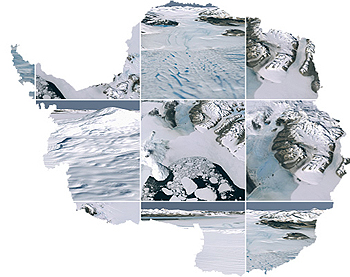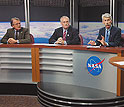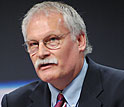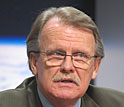News Release 07-179
Newly Unveiled Satellite Map of Antarctica Is a Unique Tool for Scientists, Educators and the Public
Joint NSF, NASA, USGS and British Antarctic Survey Project embodies the International Polar Year spirit
November 27, 2007
For b-roll of Antarctica, contact Dena Headlee at dheadlee@nsf.gov.
This material is available primarily for archival purposes. Telephone numbers or other contact information may be out of date; please see current contact information at media contacts.
Three federal agencies and the British Antarctic Survey (BAS) today unveiled a uniquely detailed and scientifically accurate satellite mosaic map of Antarctica that is expected to become a standard geographic reference and will give both scientists and the general public an unmatched tool for studying the southernmost continent.
Representatives of the National Science Foundation (NSF), the U. S. Geological Survey (USGS), the National Aeronautics and Space Administration (NASA) and BAS worked cooperatively to produce the Landsat Image Mosaic of Antarctica (LIMA), a map that combines more than 1,100 hand-selected Landsat satellite scenes digitally compiled to create a single, seamless, cloud-free image.
The new map was introduced to the media and public during an event at NASA's Goddard Space Flight Center in Greenbelt, Md.
At a moment in history when there is unprecedented concern about the state of the polar ice caps in the face of documented regional Arctic and Antarctic warming trends, the LIMA mosaic provides a critical "snapshot in time" of of Antarctica's ice sheets, which contain over 60 percent the world's fresh water, noted Scott Borg, director of NSF's division of Antarctic sciences.
"But LIMA is also a fundamental tool for scientists. It will be used in every discipline from biology to geology to glaciology, both to answer scientific questions and plan fieldwork in the vast unexplored tracts of Antarctica. For educators, students, and the general public, LIMA will bring to life the Antarctic continent like nothing before it," Borg said. "Imagine a middle-school Earth-science student comparing landforms in the glaciated valleys of Antarctic to similar features in the Rocky Mountains or even comparing a rock glacier in Antarctica with some of the features scientists are studying in images from Mars."
"This mosaic draws on 35 years of experience by the USGS's Earth Resources Observation and Science (EROS) center, whose goals include the preservation of and access to the Nation's remotely sensed land data assets through the National Satellite Land Remote Sensing Data Archive," said Barbara Ryan, USGS associate director for geography. LIMA was produced using EROS images from the Landsat 7 satellite launched in 1999.
The Landsat Program began in 1972, with the launch of the first Landsat satellite. "Sensors aboard Landsat satellites have captured millions of digital images of the Earth's land masses and coastal regions used by researchers worldwide to study global change, natural disasters, and other aspects of the Earth's terrestrial environment," Ryan said.
Robert Bindschadler, chief scientist of the Hydrospheric and Biospheric Sciences Laboratory at Goddard, noted that the new mosaic is the most detailed map of the continent in existence and offers the most geographically accurate, true-color views of the continent possible. "This innovation, compared to what we had available most recently, is like watching the most spectacular high-definition TV in living color versus watching the picture on a small black-and-white television,"he said.
An NSF grant provided the nearly $1 million U.S. contribution to the LIMA project. Tom Wagner, earth sciences program director for the NSF-managed U.S. Antarctic Program, noted that this project is the first major scientific product of the International Polar year (IPY).
"LIMA represents the true spirit of the IPY in two ways," Wagner said. "Firstly, it's an international collaboration between the U.S. and the United Kingdom, and secondly, the map and raw data are freely available to the world community of scientists, educators, and the general public."
IPY is a coordinated international field campaign that began in March 2007. During IPY, hundreds of scientists from more than 60 nations will deploy to the Arctic and Antarctic to study a range of disciplines. IPY marks the beginning of a sustained effort to understand large-scale environmental change in the Earth's polar regions. NSF is the lead U.S. agency for IPY.
Wagner added that apart from the international collaboration with the British Antarctic Survey, the project is a major interagency collaborative, with both USGS and NASA playing unique and key roles in bringing the map into existence, and that the LIMA project grew out of a "grassroots" scientific consensus across the government that the project had merit.
Two researchers, Jerry Mullins, at USGS, and Bindschadler, at NASA, he added, were instrumental in LIMA's development.
"Recognizing that change was afoot in the mapping community, Jerry Mullins, with NSF's support, organized a meeting of Antarctic researchers to determine their needs for information about Antarctica. And it quickly became apparent that LandSat imagery had great potential but needed to be shaped into a new map for its potential to be realized," Wagner said.
Wagner said that "Bob Bindschadler had the foresight many years ago to convince NASA that the Landsat satellite should collect data over Antarctica. His group also picked all of the images that make up the mosaic. It wasn't easy work; many thousands of scenes were considered and rejected. New techniques to interpret the data were also developed by Bob's group just for this project."
-NSF-
-
Nov. 27 LIMA Press Briefing
Credit and Larger Version -
Robert Bindschadler, Chief Scientist at NASA's Goddard Space Flight Center, Greenbelt, Md.
Credit and Larger Version -
Scott Borg, director of NSF's division of Antarctic sciences
Credit and Larger Version -
Ray Byrnes, liaison for satellite missions at the U.S. Geological Survey in Reston, Va.
Credit and Larger Version
Media Contacts
Peter West, NSF, (703) 292-7761, email: pwest@nsf.gov
Denver Makle, USGS, (703) 648-4732, email: dmakle@usgs.gov
Tabatha Thompson, NASA Headquarters, (202) 358-3895, email: tabatha.thompson-1@nasa.gov
Program Contacts
Thomas P. Wagner, NSF, (703) 292-4746, email: twagner@nsf.gov
Related Websites
U.S. Government Web Portal for the International Polar Year: http://www.ipy.gov
The U.S. Geological Survey's LIMA Web site: http://lima.usgs.gov/
NASA 's LIMA Web site: http://lima.nasa.gov/
The British Antarctic Survey's Web site: http://www.antarctica.ac.uk/
The U.S. National Science Foundation propels the nation forward by advancing fundamental research in all fields of science and engineering. NSF supports research and people by providing facilities, instruments and funding to support their ingenuity and sustain the U.S. as a global leader in research and innovation. With a fiscal year 2023 budget of $9.5 billion, NSF funds reach all 50 states through grants to nearly 2,000 colleges, universities and institutions. Each year, NSF receives more than 40,000 competitive proposals and makes about 11,000 new awards. Those awards include support for cooperative research with industry, Arctic and Antarctic research and operations, and U.S. participation in international scientific efforts.
Connect with us online
NSF website: nsf.gov
NSF News: nsf.gov/news
For News Media: nsf.gov/news/newsroom
Statistics: nsf.gov/statistics/
Awards database: nsf.gov/awardsearch/
Follow us on social
Twitter: twitter.com/NSF
Facebook: facebook.com/US.NSF
Instagram: instagram.com/nsfgov





